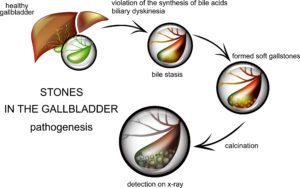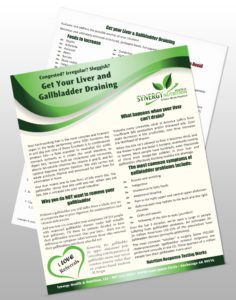Your hard-working liver is the most complex and heaviest organ in the body performing some 500+ functions day in and day out. One of those functions is to continuously produce bile—a fluid essential to neutralize the acidic stomach contents as it enters the small intestine, to digest fats, remove built-up cholesterol and hormones, absorb fat-soluble vitamins like vitamin A and D, and for optimal digestive enzyme function. Bile also carries out waste products filtered and processed by your liver for elimination in feces.
Your liver makes one to two liters of bile every day. The gallbladder stores that bile until you eat. When you eat fats, bile is released into your small intestine.
What happens when your liver and gallbladder don’t drain
Virtually every unhealthy adult in America suffers from insufficient bile production and/or thickened bile. Even slight decreases in bile production, over time, increases the likelihood of disease.
When the bile isn’t allowed to flow it becomes thick, and the thicker it gets the faster it hardens, eventually turning to stones. Most people have hundreds, even thousands of these thick sludge-like pebbles in their liver and gallbladder, effectively blocking healthy bile drainage.
The most common symptoms of gallbladder problems include:
 Nausea and vomiting
Nausea and vomiting- Indigestion
- Intolerance to fatty foods
- Abdominal bloating
- Pain in the right upper and central upper abdomen
- Referred pain may radiate to the back and the right shoulder
- Chills and sweats
- Yellowing of the skin or eyes (jaundice)
Over the last 3 decades, we’ve seen a surge in people suffering from gallbladder problems. An estimated 20-25 million Americans (10-15% of the population) have gallbladder disease (primarily gallstones) that lead to 1.8 million hospital visits and $6.2 billion dollars in health care costs each year.
The most common “solution” to gall bladder problems is surgery. Some 750,000 cholecystectomies (gallbladder removal surgeries) are performed annually in the US. Three quarters of a million people lose their gallbladder every year!
Why you would NOT want to remove your gallbladder
First of all, it is a near guarantee that without a gallbladder you will now suffer from a whole new set of symptoms due to poor digestion, fat malabsorption, and vitamin deficiencies.
And you may not even solve your symptoms: A 2004 study in the Netherlands tracked 233 people who their doctors suspected had gallbladder disease based on their symptoms. Ultrasound verified that under half actually had gallstones. Of those with ultra-sound verified gallstones, 81 patients decided to have their gallbladder removed. One year later… whether they kept their gallbladder or had it removed made no difference: two-thirds of those who kept their gallbladder despite having gallstones felt better. So did two-thirds of those who had their gallbladder removed; and… two-thirds of the 110 people who didn’t have gallstones felt symptom relief.
These findings indicate that gallstones do not exclusively cause severe, steady, upper abdominal pain, nor can symptom relief exclusively be attributed to gallstone removal. Having the gallbladder removed in the case of upper abdominal pain coinciding with the presence of gallbladder stones may rest on common practice rather than on evidence-based medicine. –M Berger
What could you do instead?
What if there was a less invasive way than surgery to relieve symptoms in people with gallbladder disease?
You may be able to prevent gallbladder surgery by eliminating certain foods from your diet.
In 1968 a forward-thinking doctor, J.C. Brenemen, published his results relieving gallstone symptoms in 100 percent of his patients by doing a 1-week elimination diet. Most symptoms improved in just 3-5 days. Of all the removed foods, eggs, pork, chicken, dairy, oranges, onions, nightshades, nuts, legumes and coffee caused the most problems when his clients later started eating them again.
In my experience with hundreds of clients who have symptoms of a sluggish liver/gallbladder, there are three additional key foods:
The overconsumption of sugar and processed foods is the #1 cause of bile obstruction. Sugar diverts your liver’s energy from manufacturing bile to detoxification.
Bad fats and oils in processed foods further clog liver drainage.
A study of people with small intestinal damage from gluten consumption (villous atrophy) took over 7 times longer to empty out their gallbladder than the normal subjects (154 minutes vs. 20 minutes). A gluten-free diet normalized the emptying time of the gallbladder.
Damage to the upper intestinal tract by either gluten or cow’s milk protein (casein) reduces pancreatic enzymes. When gluten and cow’s milk are removed from the diet and the intestines heal, the pancreatic enzyme function returns to normal.
Symptoms of poor liver/gallbladder function
Over time, if your liver cannot drain through your gallbladder, it becomes congested. You no longer eliminate toxic waste or perform the other 500+ liver functions very well and will suffer a variety of diverse symptoms:
|
|
Improve liver/gallbladder drainage and avoid stones
Stasis, where bile sits in the gallbladder for long periods of time, forms a supersaturated sludge. This stagnant sludge allows for the perfect environment for crystal-like structures to form that precipitate out of solution. Known as gallstones, these crystals irritate the gallbladder. If the stones are large enough, they may get lodged in the cystic duct or common bile duct; the sudden pain phenomenon that often sends people to the emergency room.
Liver/Gallbladder Drainage is vital for the chronically constipated and biliary-insufficient person. It is also ideal for those who have had their gallbladder removed, or whose symptoms of gallbladder dysfunction are still present.
It all starts with eliminating inflammatory foods and replacing them with foods aimed at helping clean out your liver and improve gallbladder response. Adding key foods…
- optimizes liver and gallbladder function
- assists in the digestion of heavy fats
- alleviates chronic constipation
- helps with allergies
- lowers cholesterol
- assists with natural detoxification
5 Things you can do now to heal your gallbladder

1. Do an Elimination Diet
By far the most effective therapy for gallbladder issues is an Elimination Diet. I routinely guide people through the steps of removing inflammatory, liver-congesting foods and replacing them with functional foods.
2. Consider a high-quality digestive enzyme supplement
When you are not digesting dietary fat properly, you may be having too many bowel movements each day. Often the stools are loose and may even float due to their high fat content. While you work on improving liver production of bile and its release from the gallbladder, you’ll benefit from specific digestive enzymes. I use Nutrition Response Testing® to work out the exact enzyme you need—no guessing!
3. Eat more vegetables and fruits
Shoot for 6 servings of vegetables and 2 servings of fruit per day. Food is powerful medicine. I love Tom Malterre’s Whole Life Nutrition Cookbook with its hundreds of vegetable recipes. And don’t forget about my ever-growing amazing and FREE recipes over at www.OurNutritionKitchen.com
4. Start consuming broccoli sprouts
Just 1/4 cup per day can decrease bilirubin deposits in the gallbladder thus reducing the likelihood of gallstone formation. Broccolli sprouts help your liver detoxify and also rebalance your intestinal microbiome. Powerful and very easy to sprout at home.
5. Consider gallbladder support supplements
Far too many websites will try to sell you this or that supplement based on never having met you.
I won’t.
Come see me in Anchorage for your Nutrition Response Testing exam. Ask about my internet special.
Let’s find and fix what’s really wrong—no guessing!
Berger, MY, Hartman, TC, van der Velden, J, & Bohnen, AM (2004) Is biliary pain exclusively related to gallbladder stones? A controlled prospective study. British Journal of General Practice. 54(505) 574-579.
Breneman JC. (1968) Allergy elimination diet as the most effective gallbladder diet. Annals of Allergy. 26 83–7
Gaby, A.R. (2009) Nutritional approaches to prevention and treatment of gallstones. Alternative Medicine Review, 14(3):258-67
Stinton, L. M., & Shaffer, E. A. (2012). Epidemiology of Gallbladder Disease: Cholelithiasis and Cancer. Gut and Liver, 6(2), 172–187.


Leave a Reply
You must be logged in to post a comment.